Effect of Loudspeakers on the In Situ Electric Field in a Driver Body Model Exposed to an Electric Vehicle Wireless Power Transfer System
Abstract
1. Introduction
2. Numerical Model and Method
2.1. Vehicle Model with WPT System
2.2. Loudspeaker Configuration
2.3. Numerical Human Body Model
2.4. Computational Methods
2.5. Post-Processing of External Magnetic Field Strength
2.6. Post-Processing of In Situ Electric Field by Volume- and Line-Averaging Method
3. Results and Discussion
3.1. Effects of Loudspeakers on the External Magnetic Field in the Vehicle
3.2. Effects of the Loudspeaker on the Difference between Volume- and Line-Averaging Methods
3.3. Loudspeaker Effects on the In Situ Induced Electric Field
3.4. Dependence of the Maximum Electric Field Strength on Separation between the Driver Model and Loudspeakers
4. Conclusions
Author Contributions
Funding
Conflicts of Interest
Appendix A
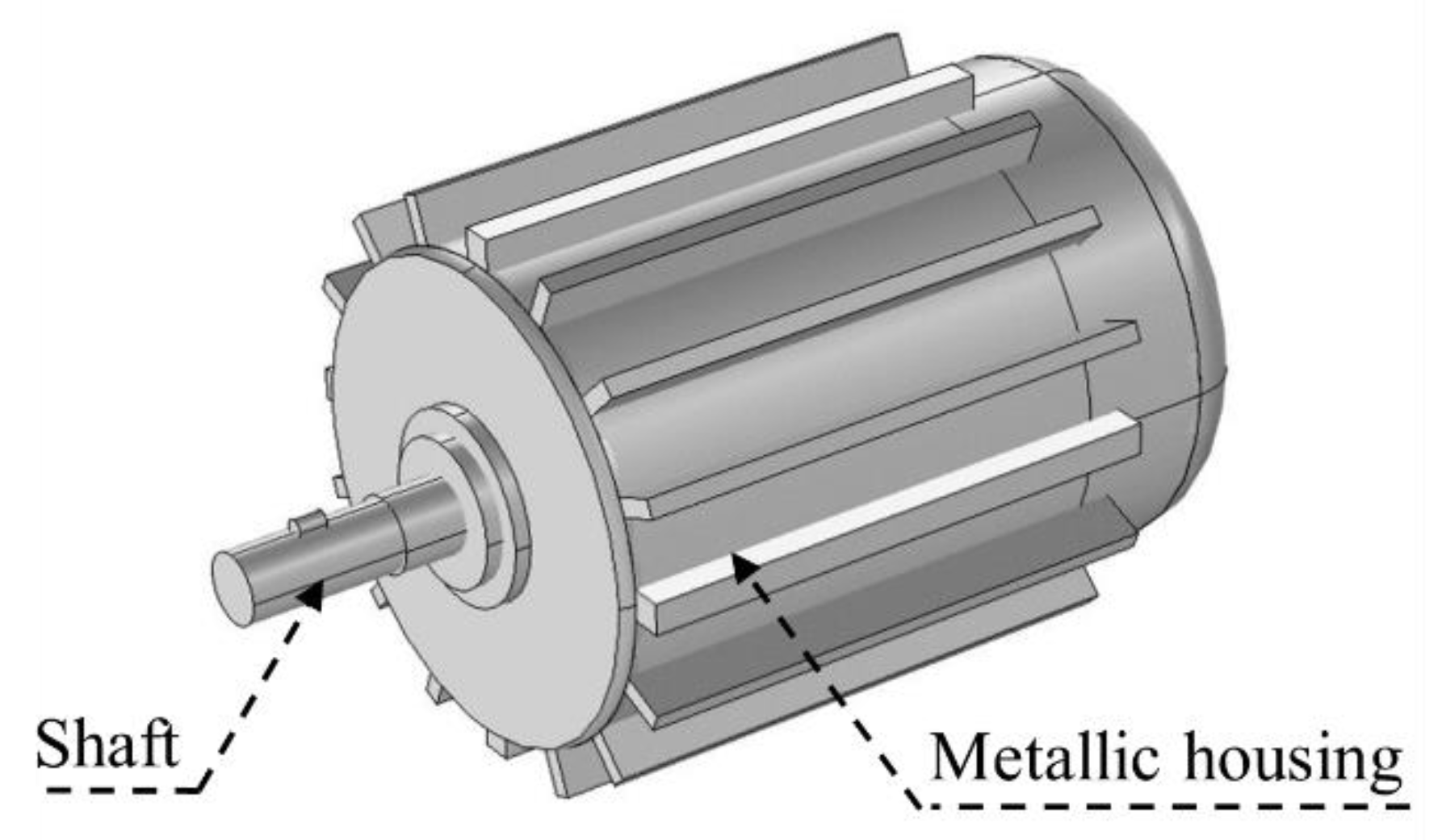
References
- Covic, G.A.; Boys, J.T. Inductive power transfer. Proc. IEEE 2013, 101, 1276–1289. [Google Scholar] [CrossRef]
- Yang, Y.; El Baghdadi, M.; Lan, Y.; Benomar, Y.; Van Mierlo, J.; Hegazy, O. Design methodology, modeling, and comparative study of wireless power transfer systems for electric vehicles. Energies 2018, 11, 1716. [Google Scholar] [CrossRef]
- Du, X.; Nie, X.; Jiao, M.; Chen, X.; Zhao, Y.; Zhao, X. Study on the Shaft EMI Noise of Electric Drive System in EV and HEV. In Proceedings of the Joint International Symposium on Electromagnetic Compatibility Sapporo and Asia-Pacific International Symposium on Electromagnetic Compatibility (EMC Sapporo/APEMC), Sapporo, Hokkaido, Japan, 3–7 June 2019; pp. 455–458. [Google Scholar]
- Pääkkönen, R.; Korpinen, L. Low Frequency Magnetic Fields inside Cars. Radiat. Prot. Dosim. 2020, 187, 268–271. [Google Scholar] [CrossRef] [PubMed]
- Ichikawa, S.; Mori, A.; Kawakubo, A. Development of short range wireless power transfer test system using magnetic resonance: (3) magnetic field characteristic of a kW-class system using solenoid coils. In Proceedings of the IEICE Communications Society Conference, Fukuoka, Japan, 17–20 September 2013. (In Japanese). [Google Scholar]
- International Commission on Non-Ionizing Radiation Protection. Guidelines for limiting exposure to time-varying electric and magnetic fields (1 Hz to 100 kHz). Health Phys. 2010, 99, 816–836. [Google Scholar]
- International Commission on Non-Ionizing Radiation Protection. Guidelines for limiting exposure to time-varying electric, magnetic, and electromagnetic fields (up to 300 GHz). Health Phys. 1998, 74, 494–522. [Google Scholar]
- International Commission on Non-Ionizing Radiation Protection. Principles for Non-Ionizing Radiation Protection. Health Phys. 2020, 118, 477–482. [Google Scholar] [CrossRef]
- IEEE International Committee on Electromagnetic Safety Technical Committee 95. Synopsis of IEEE Std C95.1™-2019 “IEEE Standard for Safety Levels with Respect to Human Exposure to Electric, Magnetic, and Electromagnetic Fields, 0 Hz to 300 GHz”. IEEE Access 2019, 7, 171346–171356. [Google Scholar] [CrossRef]
- Chen, X.L.; Umenei, A.E.; Baarman, D.W.; Chavannes, N.; De Santis, V.; Mosig, J.R.; Kuster, N. Human exposure to close-range resonant wireless power transfer systems as a function of design parameters. IEEE Trans. Electromagnet. Compat. 2014, 56, 1027–1034. [Google Scholar] [CrossRef]
- Park, S.W.; Wake, K.; Watanabe, S. Incident electric field effect and numerical dosimetry for a wireless power transfer system using magnetically coupled resonances. IEEE Trans. Microw. Theory Tech. 2013, 61, 3461–3469. [Google Scholar] [CrossRef]
- Laakso, I.; Tsuchida, S.; Hirata, A.; Kamimura, Y. Evaluation of SAR in a human body model due to wireless power transmission in the 10 MHz band. Phys. Med. Biol. 2012, 57, 4991–5002. [Google Scholar] [CrossRef]
- Christ, A.; Douglas, M.; Nadakuduti, J.; Kuster, N. Assessing human exposure to electromagnetic fields from wireless power transmission systems. Proc. IEEE 2013, 101, 1482–1493. [Google Scholar] [CrossRef]
- Kos, B.; Valič, B.; Miklavčič, D.; Kotnik, T.; Gajšek, P. Pre-and post-natal exposure of children to EMF generated by domestic induction cookers. Phys. Med. Biol. 2011, 56, 6149–6160. [Google Scholar] [CrossRef]
- Miwa, K.; Takenaka, T.; Hirata, A. Electromagnetic Dosimetry and Compliance for Wireless Power Transfer Systems in Vehicles. IEEE Trans. Electromagn. Compat. 2019, 61, 2024–2030. [Google Scholar] [CrossRef]
- International Electrotechnical Commission. Assessment of Electronic and Electrical Equipment Related to Human Exposure Restrictions for Electromagnetic Fields (0 Hz–300 GHz); IEC: Geneva, Switzerland, 2007. [Google Scholar]
- International Electrotechnical Commission. Measurement Methods for Electromagnetic Fields of Household Appliances and Similar Apparatus with Regard to Human Exposure Geuneva; IEC: Geneva, Switzerland, 2005. [Google Scholar]
- Shimamoto, T.; Laakso, I.; Hirata, A. Internal electric field in pregnant-woman model for wireless power transfer systems in electric vehicles. Electron. Lett. 2015, 51, 2136–2137. [Google Scholar] [CrossRef]
- Shimamoto, T.; Laakso, I.; Hirata, A. In-situ electric field in human body model in different postures for wireless power transfer system in an electrical vehicle. Phys. Med. Biol. 2015, 60, 163–173. [Google Scholar] [CrossRef] [PubMed]
- De Santis, V.; Campi, T.; Cruciani, S.; Laakso, I.; Feliziani, M. Assessment of the induced electric fields in a carbon-fiber electrical vehicle equipped with a wireless power transfer system. Energies 2018, 11, 684. [Google Scholar] [CrossRef]
- Shah, I.A.; Yoo, H. Assessing human exposure with medical implants to electromagnetic fields from a wireless power transmission system in an electric vehicle. IEEE Trans. Electromagn. Compat. 2019, 62, 338–345. [Google Scholar] [CrossRef]
- Park, S.W. Evaluation of electromagnetic exposure during 85 kHz wireless power transfer for electric vehicles. IEEE Trans. Magn. 2017, 54, 1–8. [Google Scholar] [CrossRef]
- Cimala, C.; Clemens, M.; Streckert, J.; Schmuelling, B. High-resolution magnetic-field exposure simulations of automotive inductive power-transfer systems using a scaled-frequency finite difference time domain approach with multi-GPU acceleration. Int. J. Numer. Model. 2017, e2231, 1–5. [Google Scholar] [CrossRef]
- Endo, S.; Bu, Y.; Mizuno, T. Copper loss reduction in wireless power transmission coil using magnetic path control technology. In Proceedings of the 21st IEEE International Conference on Electrical Machines and Systems (ICEMS), Jeju, Korea, 7–10 October 2018; pp. 2587–2592. [Google Scholar]
- Sergeant, P.; Van den Bossche, A. Inductive coupler for contactless power transmission. IET Electr. Power Appl. 2008, 2, 1–7. [Google Scholar] [CrossRef]
- Whittow, W.G.; Edwards, R.M. A Study of Changes to Specific Absorption Rates in the Human Eye Close to Perfectly Conducting Spectacles within the Radio Frequency Range 1.5 to 3.0 GHz. IEEE Trans. Antennas Propag. 2004, 52, 3207–3212. [Google Scholar] [CrossRef]
- Cihangir, A.; Whittow, W.G.; Panagamuwa, C.J.; Ferrero, F.; Jacquemod, G.; Gianesello, F.; Luxey, C. Feasibility study of 4G cellular antennas for eyewear communicating devices. IEEE Antennas Wirel. Propag. Lett. 2013, 12, 1704–1707. [Google Scholar] [CrossRef]
- Bernardi, P.; Cavagnaro, M.; Pisa, S. Evaluation of the SAR distribution in the human head for cellular phones used in a partially closed environment. IEEE Trans. Electromagn. Compat. 1996, 38, 357–366. [Google Scholar] [CrossRef]
- SAE TIR J2954. Wireless Power Transfer for Light-Duty Plug-In/Electric Vehicles and Alignment Methodology; SAE International: Warrendale, PA, USA, 2016. [Google Scholar]
- Laakso, I.; Hirata, A.; Fujiwara, O. IEEE Computational dosimetry for wireless charging of an electrical vehicle. In Proceedings of the 2014 International Symposium on Electromagnetic Compatibility, Tokyo, Japan, 12–16 May 2014; pp. 202–205. [Google Scholar]
- Bortot, L. Optimization of Demodulation Rings in Professional Louspeakers. Doctoral Thesis, University of Padua, Padua, Italy, 20 December 2012. [Google Scholar]
- Gabriel, S.; Lau, R.W.; Gabriel, C. The dielectric properties of biological tissues: III. Parametric models for the dielectric spectrum of tissues. Phys. Med. Biol. 1996, 41, 2271–2293. [Google Scholar] [CrossRef]
- International Electrotechnical Commission. Measurement Procedures of Magnetic Field Levels Generated by Electronic and Electrical Equipment in the Automotive Environment with Respect to Human Exposure-Part 1: Low Frequency Magnetic Fields; IEC: Geneva, Switzerland, 2019. [Google Scholar]
- Christ, A.; Douglas, M.G.; Roman, J.M.; Cooper, E.B.; Sample, A.P.; Waters, B.H.; Smith, J.R.; Kuster, N. Evaluation of wireless resonant power transfer systems with human electromagnetic exposure limits. IEEE Trans. Electromagn. Compat. 2012, 55, 265–274. [Google Scholar] [CrossRef]
- Laakso, I.; Hirata, A. Fast multigrid-based computation of the induced electric field for transcranial magnetic stimulation. Phys. Med. Biol. 2012, 57, 7753–7765. [Google Scholar] [CrossRef]
- International Commission on Non-Ionizing Radiation Protection. Gaps in Knowledge Relevant to the “Guidelines for Limiting Exposure to Time-Varying Electric and Magnetic Fields (1 Hz–100 kHz). Health Phys. 2020, 118, 533–542. [Google Scholar] [CrossRef]
- Laakso, I.; Hirata, A. Reducing the staircasing error in computational dosimetry of low-frequency electromagnetic fields. Phys. Med. Biol. 2012, 57, 25–34. [Google Scholar] [CrossRef]
- Diao, Y.; Gomez-Tames, J.; Rashed, E.A.; Kavet, R.; Hirata, A. Spatial Averaging Schemes of in Situ Electric Field for Low-Frequency Magnetic Field Exposures. IEEE Access 2019, 7, 184320. [Google Scholar] [CrossRef]
- Kurs, A.; Karalis, A.; Moffatt, R.; Joannopoulos, J.D.; Fisher, P.; Soljačić, M. Wireless power transfer via strongly coupled magnetic resonances. Science 2007, 317, 83–86. [Google Scholar] [CrossRef]

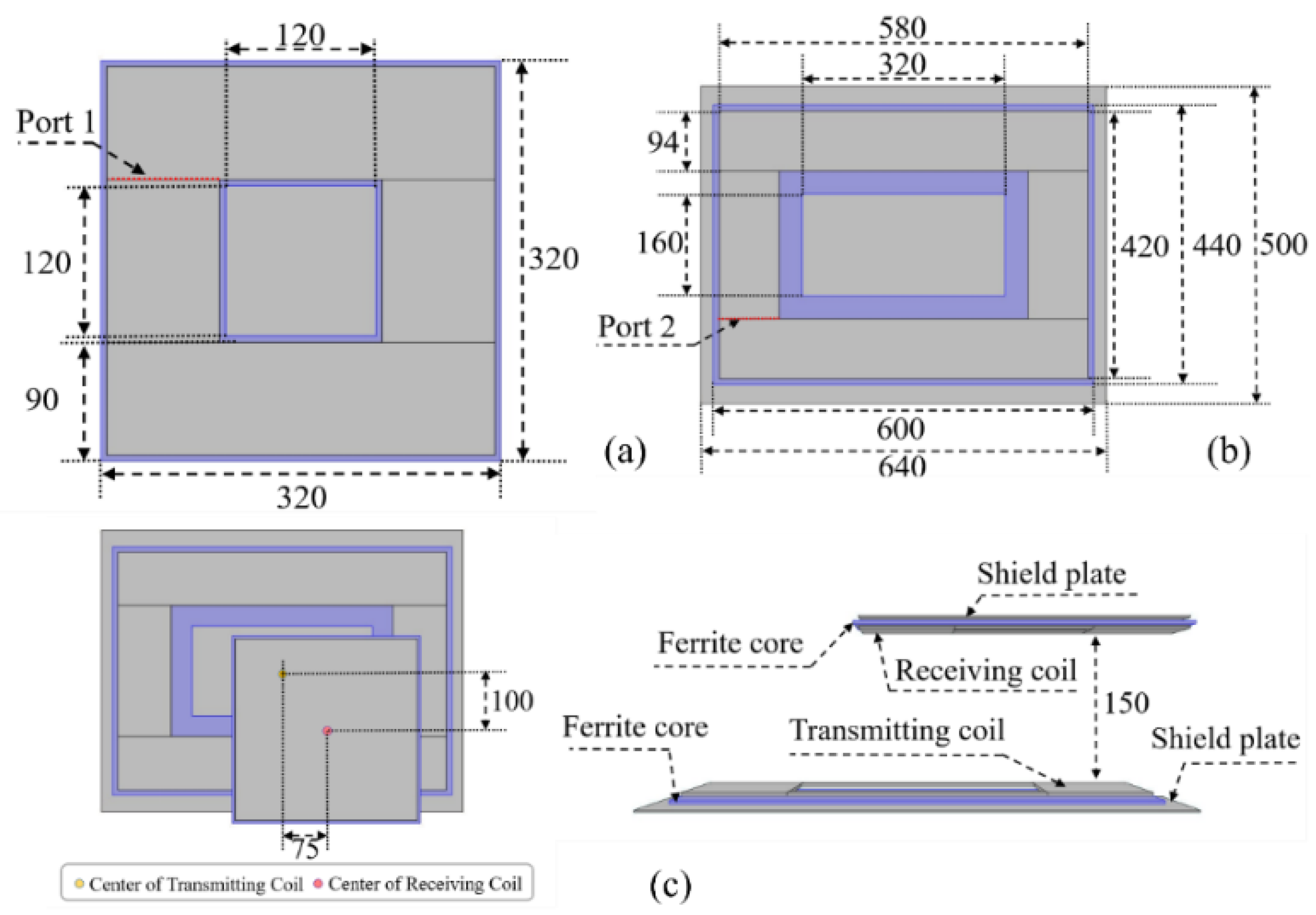
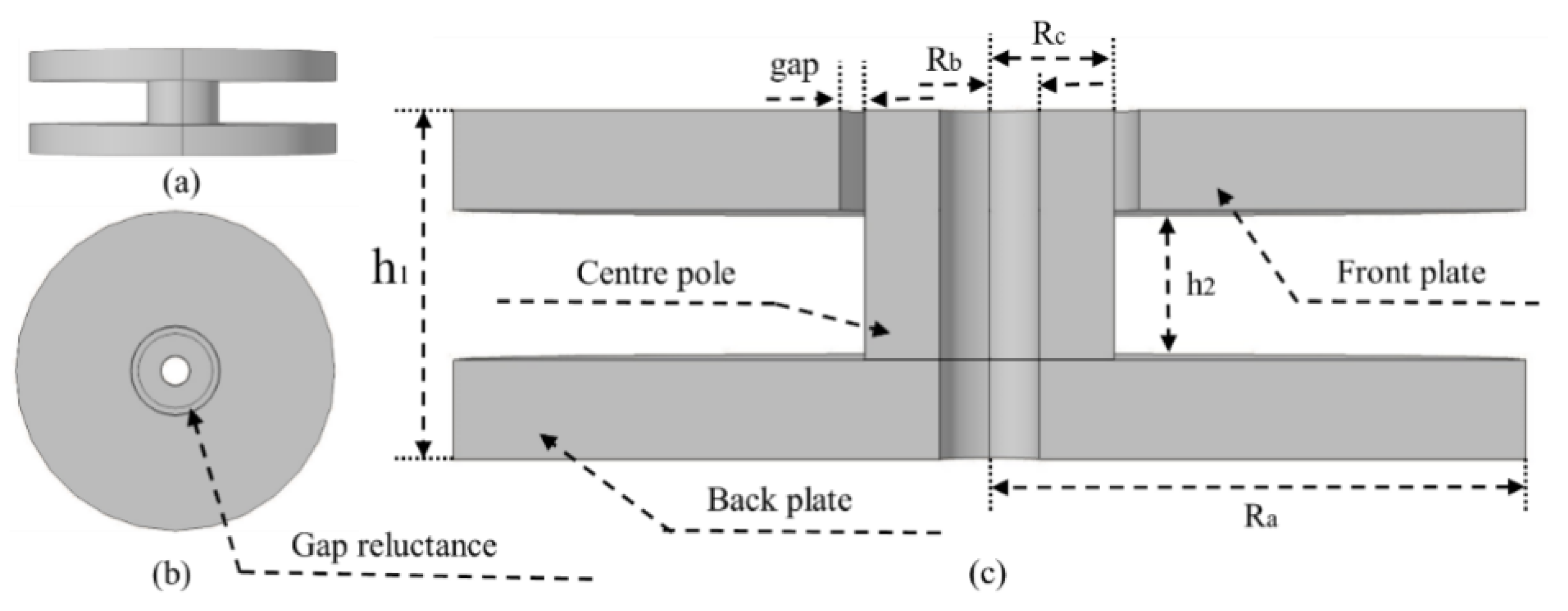


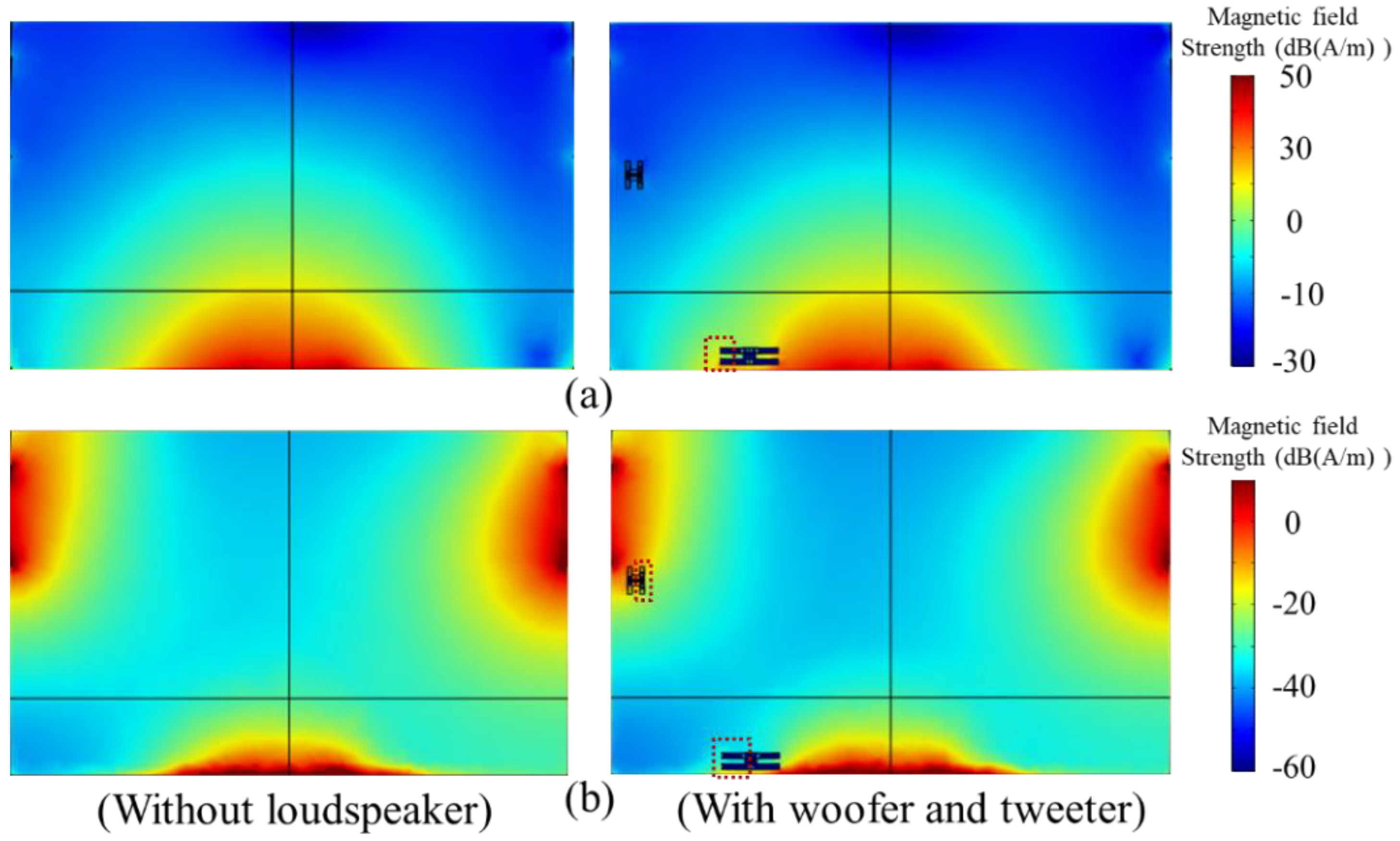
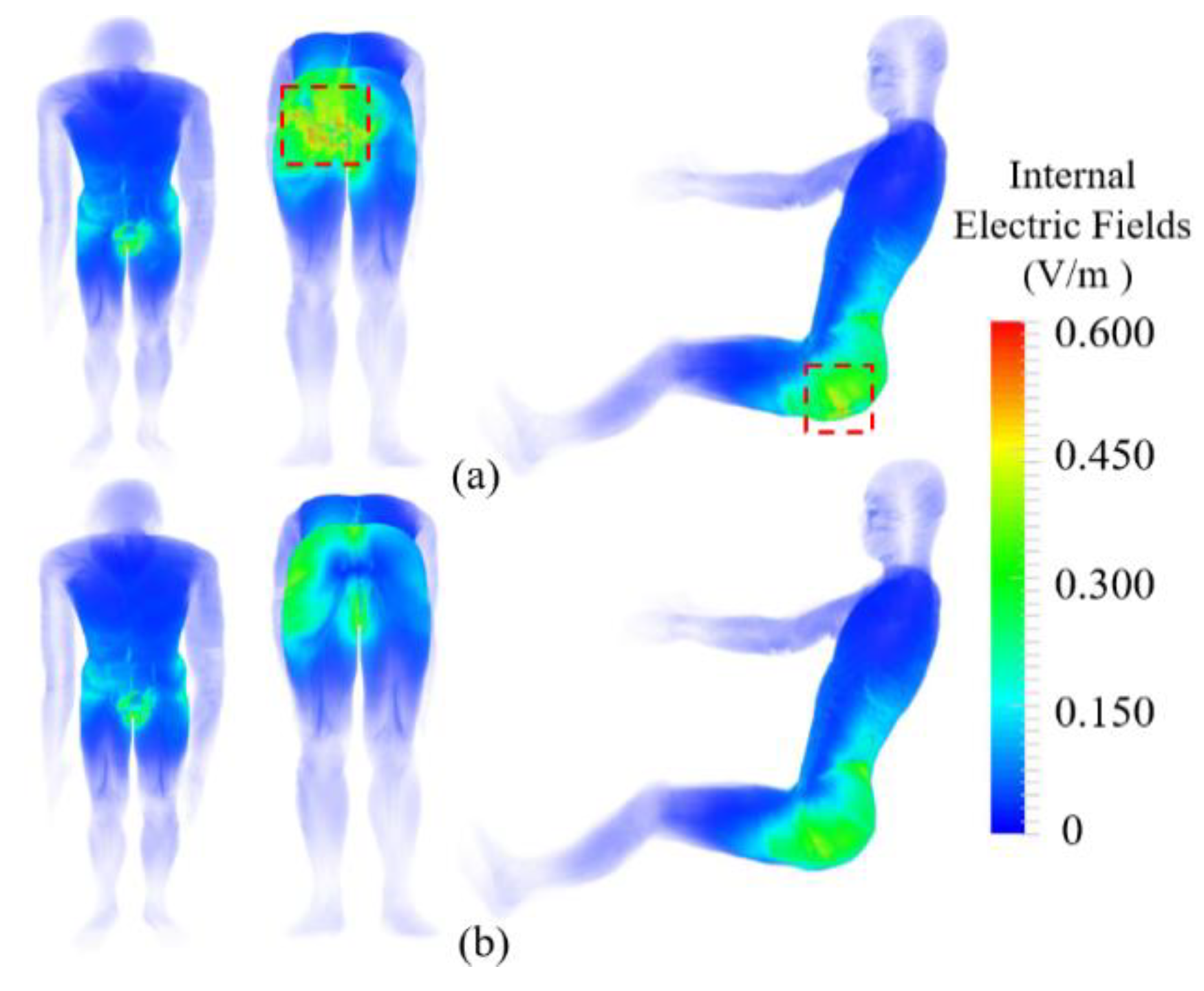
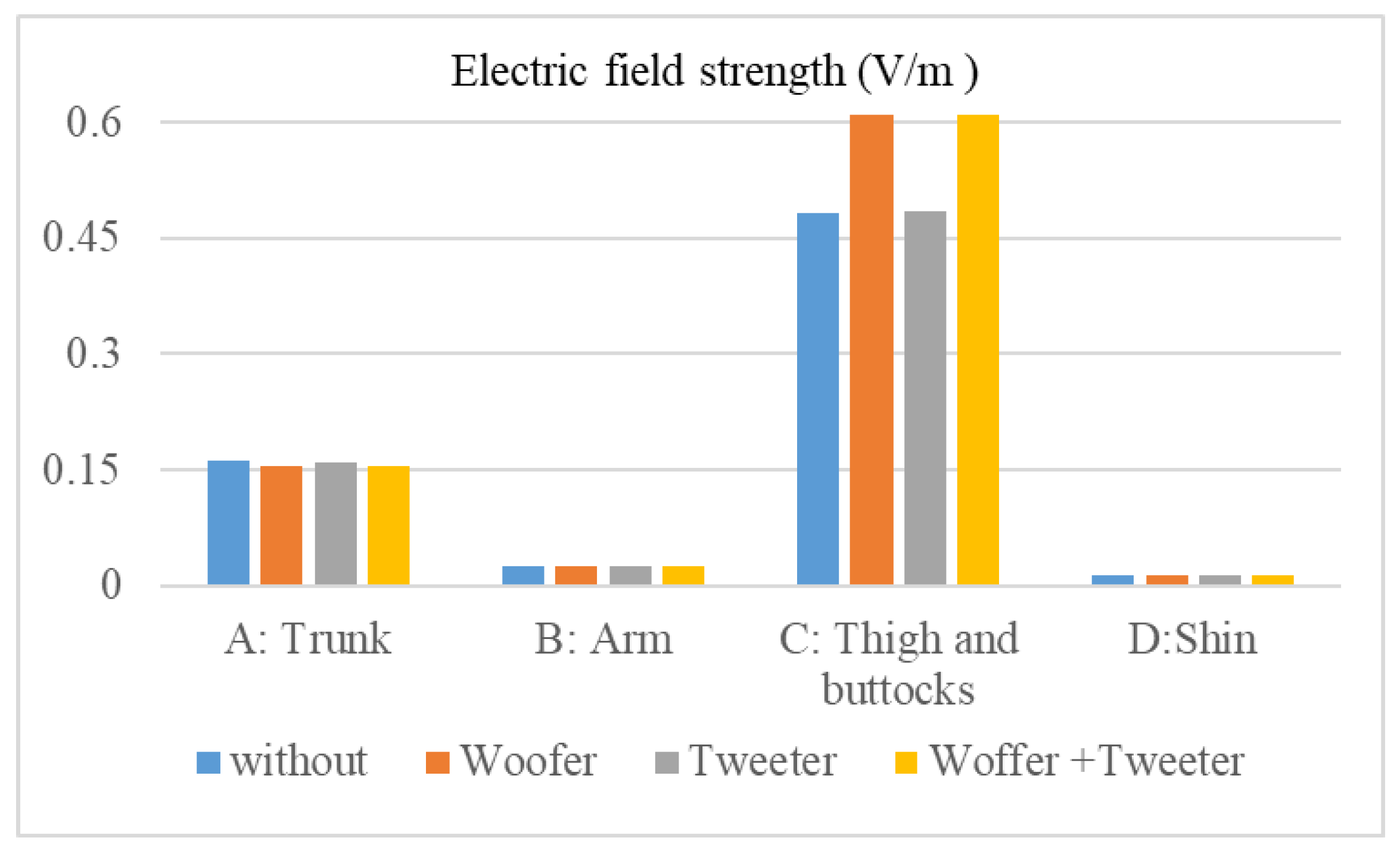
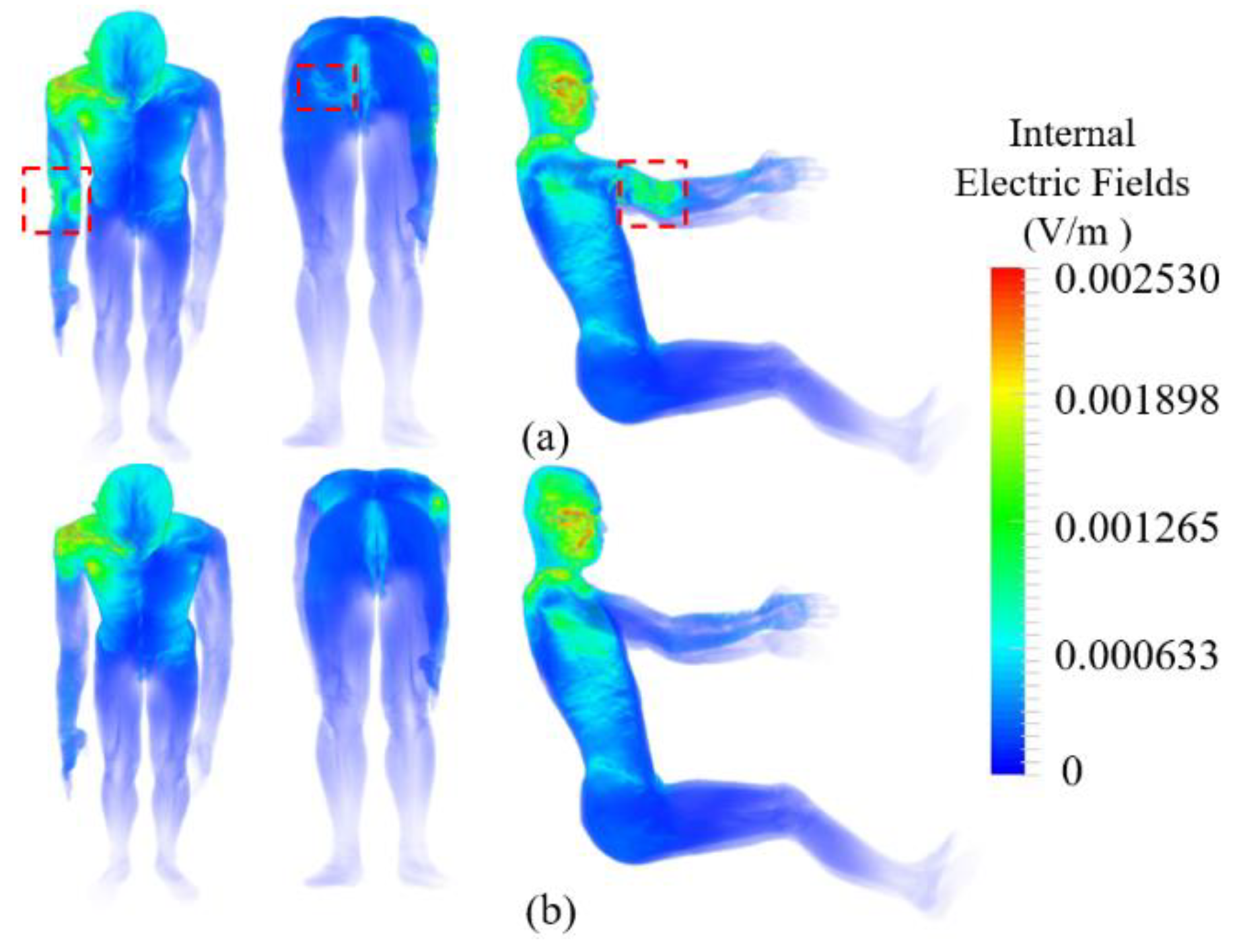

| Structure Name | Woofer | Tweeter |
|---|---|---|
| Ra | 107.5 | 50 |
| Rb | 5 | 5 |
| Rc | 25 | 25 |
| h1 | 70 | 60 |
| h2 | 20 | 30 |
| gap | 10 | 5 |
| Exposure Scenario | A: Trunk | B: Arm | C: Thigh and Buttocks | D: Shin |
|---|---|---|---|---|
| CFRP vehicle with loudspeakers | 2.45 | 0.652 | 46.5 | 1.098 |
| CFRP vehicle without loudspeakers | 2.60 | 0.665 | 41.7 | 1.070 |
| Aluminum vehicle with loudspeakers | 0.0286 | 0.0355 | 0.0087 | 0.427 |
| Aluminum vehicle without loudspeakers | 0.0284 | 0.0354 | 0.0085 | 0.427 |
| A: Trunk | B: Arm | C: Thigh and Buttocks | D: Shin | ||||||||||
|---|---|---|---|---|---|---|---|---|---|---|---|---|---|
| Percentile (%) | EV | EL | dr (%) | EV | EL | dr (%) | EV | EL | dr (%) | EV | EL | dr (%) | |
| With Loudspeaker | Max | 0.421 | 0.355 | 16.9 | 0.06 | 0.051 | 14.8 | 2.274 | 1.763 | 25.3 | 0.035 | 0.029 | 16.5 |
| 99.9 | 0.155 | 0.15 | 3.1 | 0.0243 | 0.0236 | 2.8 | 0.610 | 0.588 | 3.6 | 0.0144 | 0.014 | 2.7 | |
| 99 | 0.091 | 0.09 | 1.8 | 0.013 | 0.0129 | 1 | 0.304 | 0.299 | 1.6 | 0.009 | 0.008 | 1.6 | |
| Without Loudspeaker | Max | 0.435 | 0.367 | 17.1 | 0.059 | 0.051 | 14.3 | 2.187 | 1.656 | 27.6 | 0.027 | 0.025 | 9.3 |
| 99.9 | 0.161 | 0.156 | 3.3 | 0.0244 | 0.0239 | 2.2 | 0.483 | 0.46 | 4.9 | 0.014 | 0.013 | 2.3 | |
| 99 | 0.093 | 0.091 | 1.8 | 0.0129 | 0.0128 | 1.2 | 0.264 | 0.26 | 1.3 | 0.008 | 0.0078 | 1.5 | |
| A: Trunk | B: Arm | C: Thigh and Buttocks | D: Shin | ||||||||||
|---|---|---|---|---|---|---|---|---|---|---|---|---|---|
| Percentile (%) | EV | EL | dr (%) | EV | EL | dr (%) | EV | EL | dr (%) | EV | EL | dr (%) | |
| With Loudspeaker | Max | 9.055 | 7.719 | 15.9 | 22.376 | 16.387 | 30.9 | 2.011 | 1.76 | 13.3 | 0.294 | 0.256 | 13.9 |
| 99.9 | 2.365 | 2.258 | 4.6 | 1.386 | 1.363 | 1.7 | 0.767 | 0.745 | 2.9 | 0.107 | 0.104 | 2.7 | |
| 99 | 1.154 | 1.128 | 2.3 | 0.356 | 0.352 | 1 | 0.446 | 0.44 | 1.4 | 0.058 | 0.057 | 1.4 | |
| Without Loudspeaker | Max | 10.635 | 6.875 | 42.9 | 1.425 | 1.082 | 27.4 | 2.04 | 1.777 | 13.8 | 0.305 | 0.268 | 12.9 |
| 99.9 | 2.333 | 2.228 | 4.6 | 0.433 | 0.422 | 2.6 | 0.737 | 0.715 | 3 | 0.11 | 0.107 | 2.7 | |
| 99 | 1.16 | 1.134 | 2.2 | 0.206 | 0.204 | 1.1 | 0.424 | 0.418 | 1.3 | 0.059 | 0.058 | 1.4 | |
| XS | A: Trunk | B: Arm | C: Thigh and Buttocks | D: Shin |
|---|---|---|---|---|
| −100 mm | 0.1593 | 0.0264 | 0.5502 | 0.0137 |
| −50 mm | 0.1621 | 0.0269 | 0.6375 | 0.0135 |
| 0 mm | 0.1570 | 0.0267 | 0.5819 | 0.0142 |
| 50 mm | 0.1534 | 0.0258 | 0.4870 | 0.0143 |
| 100 mm | 0.1506 | 0.0258 | 0.4438 | 0.0152 |
| Without woofer | 0.1612 | 0.0244 | 0.4833 | 0.0135 |
| YS | A: Trunk | B: Arm | C: Thigh and Buttocks | D: Shin |
|---|---|---|---|---|
| −150 mm | 0.1569 | 0.0257 | 0.5994 | 0.0136 |
| −100 mm | 0.1546 | 0.0243 | 0.6096 | 0.0144 |
| −50 mm | 0.1557 | 0.0237 | 0.5996 | 0.0142 |
| 0 mm | 0.1570 | 0.0267 | 0.5819 | 0.0142 |
| 50 mm | 0.1615 | 0.0267 | 0.5695 | 0.0135 |
| 100 mm | 0.1608 | 0.0256 | 0.5444 | 0.0138 |
| 150 mm | 0.1612 | 0.0247 | 0.5048 | 0.0138 |
| Without woofer | 0.1612 | 0.0244 | 0.4833 | 0.0135 |
| ZS | A: Trunk | B: Arm | C: Thigh and Buttocks | D: Shin |
|---|---|---|---|---|
| −50 mm | 2.303 | 1.575 | 0.774 | 0.108 |
| 0 mm | 2.310 | 1.711 | 0.773 | 0.109 |
| 50 mm | 2.365 | 1.386 | 0.767 | 0.107 |
| 100 mm | 2.253 | 0.394 | 0.768 | 0.109 |
| Without tweeter | 2.333 | 0.433 | 0.737 | 0.110 |
© 2020 by the authors. Licensee MDPI, Basel, Switzerland. This article is an open access article distributed under the terms and conditions of the Creative Commons Attribution (CC BY) license (http://creativecommons.org/licenses/by/4.0/).
Share and Cite
Lan, J.; Hirata, A. Effect of Loudspeakers on the In Situ Electric Field in a Driver Body Model Exposed to an Electric Vehicle Wireless Power Transfer System. Energies 2020, 13, 3635. https://doi.org/10.3390/en13143635
Lan J, Hirata A. Effect of Loudspeakers on the In Situ Electric Field in a Driver Body Model Exposed to an Electric Vehicle Wireless Power Transfer System. Energies. 2020; 13(14):3635. https://doi.org/10.3390/en13143635
Chicago/Turabian StyleLan, Junqing, and Akimasa Hirata. 2020. "Effect of Loudspeakers on the In Situ Electric Field in a Driver Body Model Exposed to an Electric Vehicle Wireless Power Transfer System" Energies 13, no. 14: 3635. https://doi.org/10.3390/en13143635
APA StyleLan, J., & Hirata, A. (2020). Effect of Loudspeakers on the In Situ Electric Field in a Driver Body Model Exposed to an Electric Vehicle Wireless Power Transfer System. Energies, 13(14), 3635. https://doi.org/10.3390/en13143635





